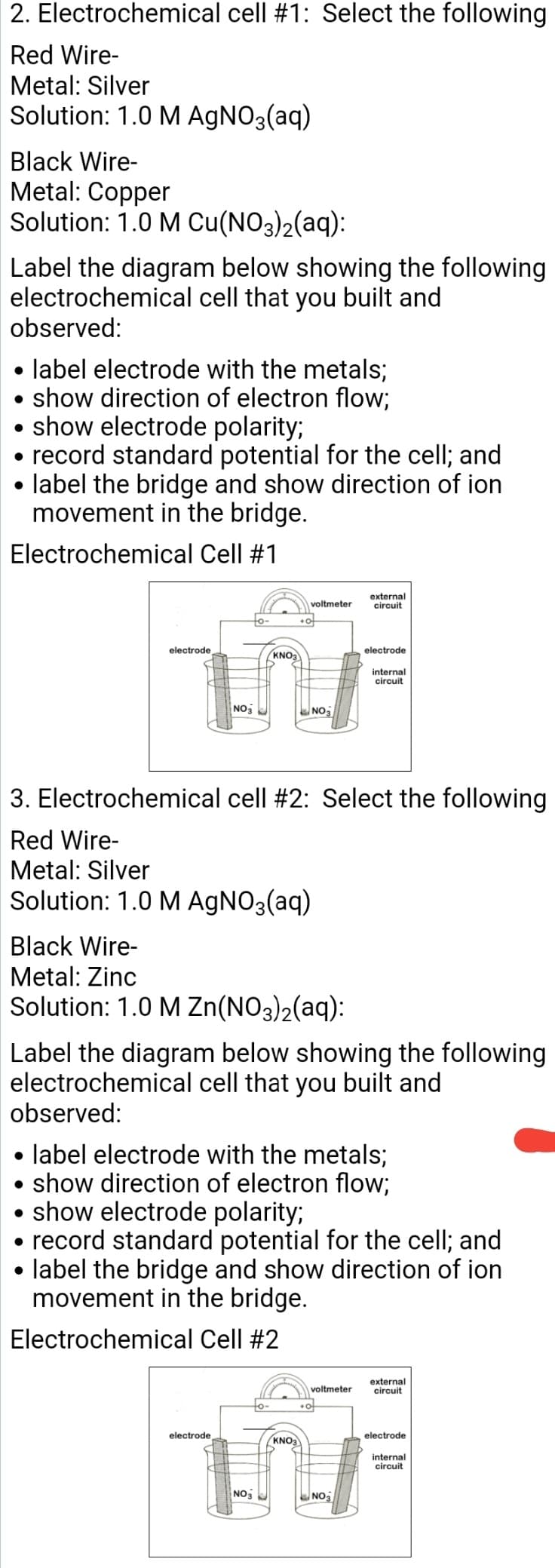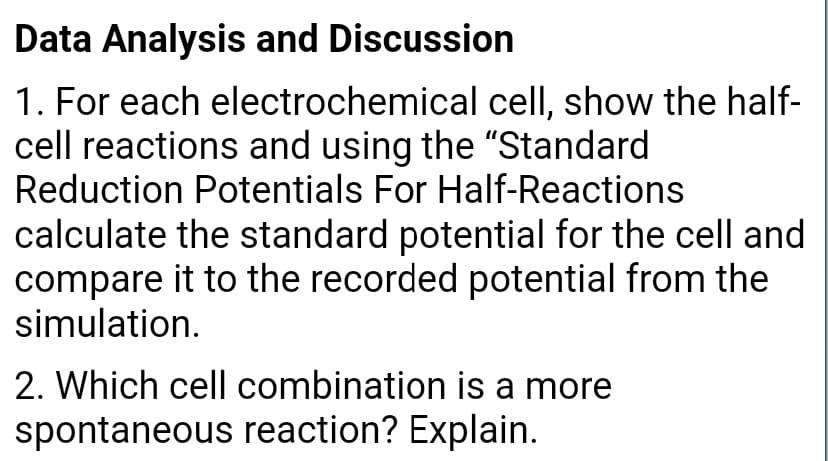Data Analysis and Discussion 1. For each electrochemical cell, show the half- cell reactions and using the "Standard Reduction Potentials For Half-Reactions calculate the standard potential for the cell and compare it to the recorded potential from the simulation. 2. Which cell combination is a more spontaneous reaction? Explain.
Data Analysis and Discussion 1. For each electrochemical cell, show the half- cell reactions and using the "Standard Reduction Potentials For Half-Reactions calculate the standard potential for the cell and compare it to the recorded potential from the simulation. 2. Which cell combination is a more spontaneous reaction? Explain.
Principles of Modern Chemistry
8th Edition
ISBN:9781305079113
Author:David W. Oxtoby, H. Pat Gillis, Laurie J. Butler
Publisher:David W. Oxtoby, H. Pat Gillis, Laurie J. Butler
Chapter17: Electrochemistry
Section: Chapter Questions
Problem 77AP
Related questions
Question
I need the answers for 1 and 2

Transcribed Image Text:2. Electrochemical cell #1: Select the following
Red Wire-
Metal: Silver
Solution: 1.0 M AGNO3(aq)
Black Wire-
Metal: Copper
Solution: 1.0 M Cu(NO3)2(aq):
Label the diagram below showing the following
electrochemical cell that you built and
observed:
• label electrode with the metals;
show direction of electron flow;
show electrode polarity;
• record standard potential for the cell; and
label the bridge and show direction of ion
movement in the bridge.
Electrochemical Cell #1
external
circuit
voltmeter
electrode
electrode
KNO3
internal
circuit
NO
NO3
3. Electrochemical cell #2: Select the following
Red Wire-
Metal: Silver
Solution: 1.0 M AGNO3(aq)
Black Wire-
Metal: Zinc
Solution: 1.0 M Zn(NO3)2(aq):
Label the diagram below showing the following
electrochemical cell that you built and
observed:
label electrode with the metals;
• show direction of electron flow;
show electrode polarity;
record standard potential for the cell; and
label the bridge and show direction of ion
movement in the bridge.
Electrochemical Cell #2
external
circuit
voltmeter
electrode
electrode
KNO3
internal
circuit
NO
NO

Transcribed Image Text:Data Analysis and Discussion
1. For each electrochemical cell, show the half-
cell reactions and using the "Standard
Reduction Potentials For Half-Reactions
calculate the standard potential for the cell and
compare it to the recorded potential from the
simulation.
2. Which cell combination is a more
spontaneous reaction? Explain.
Expert Solution
This question has been solved!
Explore an expertly crafted, step-by-step solution for a thorough understanding of key concepts.
Step by step
Solved in 2 steps with 3 images

Knowledge Booster
Learn more about
Need a deep-dive on the concept behind this application? Look no further. Learn more about this topic, chemistry and related others by exploring similar questions and additional content below.Recommended textbooks for you

Principles of Modern Chemistry
Chemistry
ISBN:
9781305079113
Author:
David W. Oxtoby, H. Pat Gillis, Laurie J. Butler
Publisher:
Cengage Learning

Chemistry: Principles and Practice
Chemistry
ISBN:
9780534420123
Author:
Daniel L. Reger, Scott R. Goode, David W. Ball, Edward Mercer
Publisher:
Cengage Learning

Chemistry & Chemical Reactivity
Chemistry
ISBN:
9781337399074
Author:
John C. Kotz, Paul M. Treichel, John Townsend, David Treichel
Publisher:
Cengage Learning

Principles of Modern Chemistry
Chemistry
ISBN:
9781305079113
Author:
David W. Oxtoby, H. Pat Gillis, Laurie J. Butler
Publisher:
Cengage Learning

Chemistry: Principles and Practice
Chemistry
ISBN:
9780534420123
Author:
Daniel L. Reger, Scott R. Goode, David W. Ball, Edward Mercer
Publisher:
Cengage Learning

Chemistry & Chemical Reactivity
Chemistry
ISBN:
9781337399074
Author:
John C. Kotz, Paul M. Treichel, John Townsend, David Treichel
Publisher:
Cengage Learning

Chemistry & Chemical Reactivity
Chemistry
ISBN:
9781133949640
Author:
John C. Kotz, Paul M. Treichel, John Townsend, David Treichel
Publisher:
Cengage Learning

Chemistry
Chemistry
ISBN:
9781305957404
Author:
Steven S. Zumdahl, Susan A. Zumdahl, Donald J. DeCoste
Publisher:
Cengage Learning

Chemistry: An Atoms First Approach
Chemistry
ISBN:
9781305079243
Author:
Steven S. Zumdahl, Susan A. Zumdahl
Publisher:
Cengage Learning